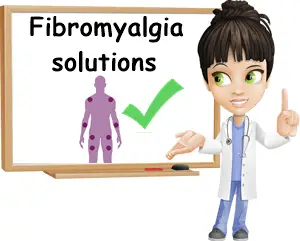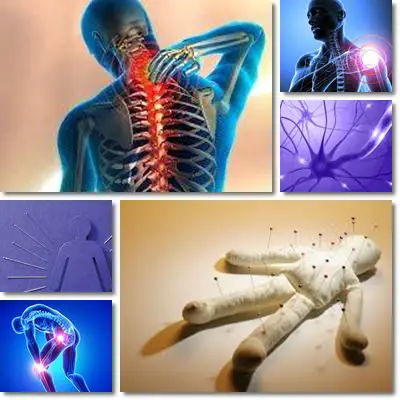As discussed in a previous article, fibromyalgia is a medical condition that causes sufferers to become more sensitive to pain stimuli and experience various forms of pain in different areas of the body at once for no apparent medical reason. The causes of fibromyalgia are unknown and there is no definitive test or medical exam that can identify the condition in a sufferer. Diagnosing it is lengthy and presupposes testing to exclude other conditions and diseases that may cause the pain symptoms reported by sufferers. Since its causes are unknown and there is hardly a way to identify its physiological presence in the body, fibromyalgia remains without a treatment.
Despite the fact there is no effective treatment available at present, fibromyalgia is manageable with palliative therapies. Pains and aches in different areas of the body can be approached individually to achieve a certain degree of relief and make living with the condition more bearable. Because it is believed that both physical and emotional factors may be involved in the onset of the condition and dictate its severity, palliative care therapies employed for fibromyalgia pain relief often aim at addressing both aspects of one’s health.

How does fibromyalgia affect us? Fibromyalgia affects both the body and the mind. The physical pain the condition engenders as well as its lengthiness and intensity become exhausting after a while and start affecting our mental disposition and wellbeing in addition to our physical health. Living with fibromyalgia is exhausting in itself. Knowing there isn’t a clear solution to the condition, whether it’s medication or surgery, adds to the frustration and can make even the best of us lose hope.
When it comes to treating fibromyalgia, the main focus is on reducing the intensity and duration of symptoms. This can be achieved with the help of various therapies aimed at specific pains and aches. Avoiding certain factors that may trigger pain and aches in various areas of the body or worsen existing ones is also helpful. Lastly, therapies directed at reducing stress levels and shaping our emotional response towards the condition itself can prove useful as well. A good approach to improving fibromyalgia symptoms takes into account the following aspects:
1) Stress reduction. Stress is a major contributor to ill health. The condition of being stressed alters the way our body functions in ways that negatively impact its good functioning and our good health. For example, chronic stress can eat up our vitamins and minerals at a faster rate, making us deficient and prone to disease. When we are stressed for some time, we can easily end up magnesium deficient (this is just one example). Being low on magnesium all the time means we are more likely to get headaches, muscle aches and pain, palpitations, extrasystoles, other forms of arrhythmia, frail bones and all sorts of pains, aches and abnormalities that target our muscles, bones, cardiovascular and nervous systems.

One of the most common types of pain in fibromyalgia is muscle pain: pulsating pain, dull aches, twitching, pins and needles sensation etc. Such types of pain are made worse by the lack of magnesium (and also caused by it), so being deficient can significantly worsen certain fibromyalgia symptoms that target the muscles. As a result, a good way to reduce symptoms is to reduce stress. By doing this, we ensure that our body doesn’t lose any important nutrients that might help keep certain symptoms under control.
2) Dietary supplements. Some organs and tissues in our body rely heavily on certain nutrients for good functioning. Magnesium is for muscles, bones, our cardiovascular and nervous system, potassium is for vascular health, vitamin A is for good immunity, but also skin and eye health, vitamin D is for the immune system, bone health and so on. Taking a multivitamin dietary supplement or individual supplements, depending on what our nutritional demands are can contribute to reducing the severity of symptoms and improve the overall impact of the condition simply because we are supplying all the tissues and organs in our body with the nourishment they need to regulate their function and prevent abnormalities that may result in various pains and aches.
For example, some researchers suggest that a nervous system imbalance may contribute to causing fibromyalgia and liken the condition with depression. One nutrient our body consumes at an insane pace at times and uses for a great variety of processes (including nervous system health) is magnesium. This dietary mineral has been shown to help restore chemical balances in the brain that ultimately lead to improving depression. Ensuring we eat or supplement with all the magnesium our body is missing may help keep symptoms under control and improve our quality of life.
But we don’t need just one nutrient. We need all 26 essential vitamins and dietary minerals. And considering the less nutritious foods that end up on our plates, our insanely rapid lifestyles, the incredible amount of stress many of us face on a daily basis, existing medical conditions that might prevent us from properly absorbing or synthesizing certain nutrients etc., it is possible that we are deficient in multiple essential nutrients and not even know it. A deficiency can occur even when we do get all the nutrients we are supposed to, but, for some reason, have higher demands.
3) Getting enough rest. Fibromyalgia is known to cause insomnia and other sleeping problems. But not sleeping enough can often worsen both physical symptoms of pain and alter the way we perceive those said symptoms. Employing various techniques to help us sleep well and be rested may contribute to improvements of the condition. Sticking to a regular sleeping schedule, going to bed as early as 8 or 9 p.m. and waking up earlier in the morning, not sleeping in when we have the chance, opening the window to let fresh air in before we go to sleep, eating smaller, lighter meals in the evening and not going to bed full, drinking herbal teas to help calm us down (lemon balm, chamomile, valerian) are some solutions to sleeping better.
4) Avoiding physical strain. Because of the nature of their pain, fibromyalgia sufferers are often advised to avoid lifting heavy weights, practicing hard manual labor, engaging in intense physical exercise and virtually any form of movement that puts too much strain on the bone frame or muscle, two of the areas most likely to experience pain symptoms. Sitting in a chair or on a sofa for too long, prolonged rest in bed, too much time spent in front of a computer or television set, bad posture can all augment pain symptoms and worsen the condition.
5) The benefits of massage. Muscle, bone and joint pain can be lessened with the help of massage. Addressing trigger points and keeping the massage gentle can prove useful in managing fibromyalgia pain. In my experience, the duration of a massage is best kept anywhere from 20 minutes to an hour. Chiropractic treatment is another great alternative which can help improve musculoskeletal pain.
6) Infrared light therapy. This somewhat novelty type of pain therapy is great for muscle, joint and bone pain and can easily be done at home with the help of small infrared light lamps. It is important to follow instructions carefully to avoid the potential side effects of misuse.
7) Acupuncture and aromatherapy. These alternative therapies may help improve certain symptoms as well as our emotional response to these symptoms, potentially contributing to improving the condition. It is best to address the emotional component of fibromyalgia as well as the physical pain because of the importance the heightened emotional response plays in both the intensity at which we experience pain and our reaction to it which may influence our quality of life and future progress.
8) Laughter therapy. Though unconventional, laughing is one of the best remedies there is. Whether it’s brought on by watching a movie, some funny videos, time spent with friends, family and other loved ones, laughing has healing properties. Because it changes our disposition through the production of endorphins, it can contribute to an overall improved state of health and quality of life. While it is not an approved medical treatment, a better disposition can alter the way our brain perceives pain and help us better deal with it.
9) A good diet. Our eating is the foundation of our health. Unhealthy foods, an excess of animal foods and fats, alcohol and caffeine can cause inflammation which can worsen muscle, joint and bone pain, but also gastrointestinal problems and other types of health issues. Anti-inflammatory foods such as turmeric, cherries and others can give a boost to our clean eating and contribute to pain management.
10) Herbal remedies. Although they may not work in the same manner for everyone, herbal teas have helped me detoxify and improved most of my gastrointestinal issues. My favorite is a mix of herbs called Quick Transit. It contains senna leaves, licorice root, apple, fennel, lemongrass, spinach seeds and several other compounds. After 3 weeks I noticed a great improvement in my gastrointestinal health and simply felt better.
11) Medication. Taking anti-inflammatory medication and other types of medicines for pain relief is common with fibromyalgia sufferers. When pain becomes too severe and interferes with daily routine, doctors may recommend muscle relaxants and other stronger medicines to help manage it better. However, it is good to keep in mind that every medicine we take has side effects and some of these side effects weigh more than the relief we may enjoy.
Conclusion
With fibromyalgia, pain never really goes away. There are times when it gets better, but also times when it can become debilitating and simple things such as walking in a supermarket or bending the head forward to check the food on the stove can generate intense pain. Living with the condition is not easy so we owe it to ourselves to try and see whether or not simple remedies such as infrared light therapy, clean eating, massage, chiropractic treatment, taking dietary supplements or reducing our stress levels and learning to enjoy life more can offer pain relief and improve our quality of life.
